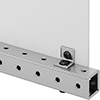Filter by
Bracket Type
Screw Size
Thickness
Rail Height
Outside Height
Outside Width
Wall Thickness
Finish
T-Slotted Framing Component
Bolt-Together Framing Component
Corner Bracket Style
Strut Channel Framing Component
Mounting Location
DFARS Specialty Metals
Building and Machinery Hardware
Raw Materials
Containers, Storage, and Furniture
Material Handling
Power Transmission
Fabricating and Machining
Fastening and Joining
Measuring and Inspecting





































































































